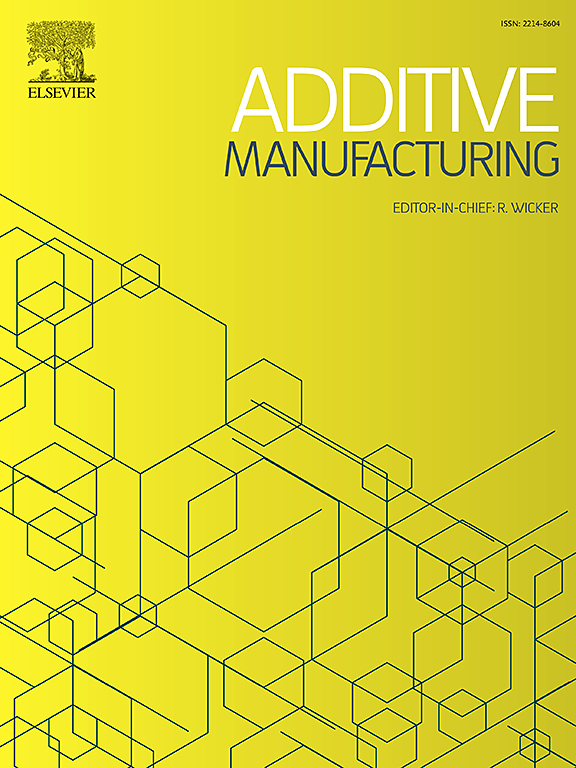Exploring the impact of volumetric additive manufacturing of photo-crosslinkable gelatin on mesenchymal stromal cell behavior and differentiation
IF 10.3
1区 工程技术
Q1 ENGINEERING, MANUFACTURING
引用次数: 0
Abstract
This study investigates photo-crosslinkable gelatin-based hydrogels - thiolated gelatin (GelSH) and gelatin norbornene (GelNB) - for volumetric additive manufacturing (VAM). GelSH was synthesized with degrees of thiol substitution (DS) of 39 %, 54 %, and 63 %, and GelNB with a DS of 60 % (with respect to primary amine content). These were combined into GelNB-GelSH photo-resins at 5, 7.5, and 10 % (w/v) and crosslinked via thiol-ene chemistry. Physico-chemical analysis showed that increasing DS and polymer concentration reduced swelling and increased moduli. VAM enabled the fabrication of high-resolution 3D hydrogel constructs from optimized formulations, demonstrating the ability to encapsulate mesenchymal stromal cells (MSCs) within a mechanically tunable, cell-supportive hydrogel environment. Film-cast hydrogels, also with embedded MSCs, served as comparative controls. VAM-printed constructs exhibited significantly higher alkaline phosphatase activity and calcium deposition, indicating enhanced osteogenesis. In contrast, chondrogenic and adipogenic differentiation were more pronounced in film-cast samples, due to their lower crosslinking density and stiffness. These findings emphasize the importance of matrix mechanics in guiding stem cell differentiation and demonstrate the potential of VAM for producing complex, functional scaffolds for tissue engineering. This work supports further development of tunable gelatin-based bioresins for applications requiring lineage-specific differentiation, including those targeting softer tissue types.
探讨光交联明胶体积增材制造对间充质间质细胞行为和分化的影响
本研究研究了光交联明胶基水凝胶-巯基明胶(GelSH)和明胶降冰片烯(GelNB) -用于体积增材制造(VAM)。GelSH的硫醇取代度(DS)分别为39 %、54 %和63 %,GelNB的硫醇取代度(DS)为60 %(伯胺含量)。它们以5、7.5和10 % (w/v)的浓度组合成GelNB-GelSH光树脂,并通过巯基化学交联。理化分析表明,增加DS和聚合物浓度可以降低溶胀,增加模量。VAM能够从优化的配方中制造出高分辨率的3D水凝胶结构,证明了在机械可调的细胞支持水凝胶环境中封装间充质基质细胞(MSCs)的能力。薄膜浇铸水凝胶,同样嵌入MSCs,作为对照。vam打印的构建体显示出更高的碱性磷酸酶活性和钙沉积,表明骨生成增强。相比之下,由于其较低的交联密度和硬度,成软骨和成脂肪的分化在膜铸样品中更为明显。这些发现强调了基质力学在指导干细胞分化中的重要性,并证明了VAM在组织工程中制造复杂、功能性支架的潜力。这项工作支持可调明胶基生物树脂的进一步发展,用于需要谱系特异性分化的应用,包括那些针对软组织类型的应用。
本文章由计算机程序翻译,如有差异,请以英文原文为准。
求助全文
约1分钟内获得全文
求助全文
来源期刊

Additive manufacturing
Materials Science-General Materials Science
CiteScore
19.80
自引率
12.70%
发文量
648
审稿时长
35 days
期刊介绍:
Additive Manufacturing stands as a peer-reviewed journal dedicated to delivering high-quality research papers and reviews in the field of additive manufacturing, serving both academia and industry leaders. The journal's objective is to recognize the innovative essence of additive manufacturing and its diverse applications, providing a comprehensive overview of current developments and future prospects.
The transformative potential of additive manufacturing technologies in product design and manufacturing is poised to disrupt traditional approaches. In response to this paradigm shift, a distinctive and comprehensive publication outlet was essential. Additive Manufacturing fulfills this need, offering a platform for engineers, materials scientists, and practitioners across academia and various industries to document and share innovations in these evolving technologies.
 求助内容:
求助内容: 应助结果提醒方式:
应助结果提醒方式:


